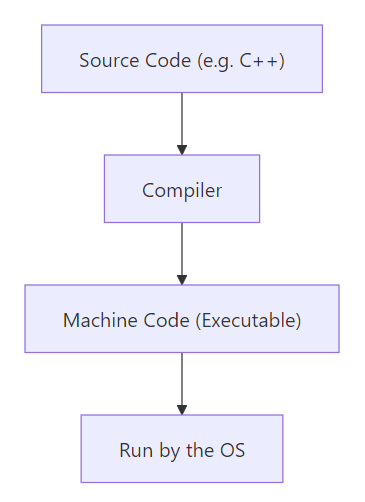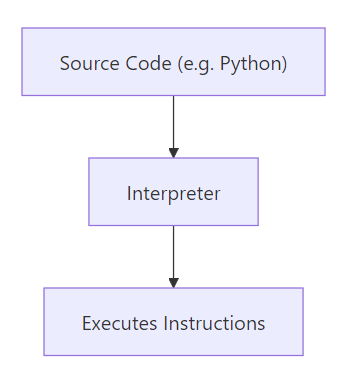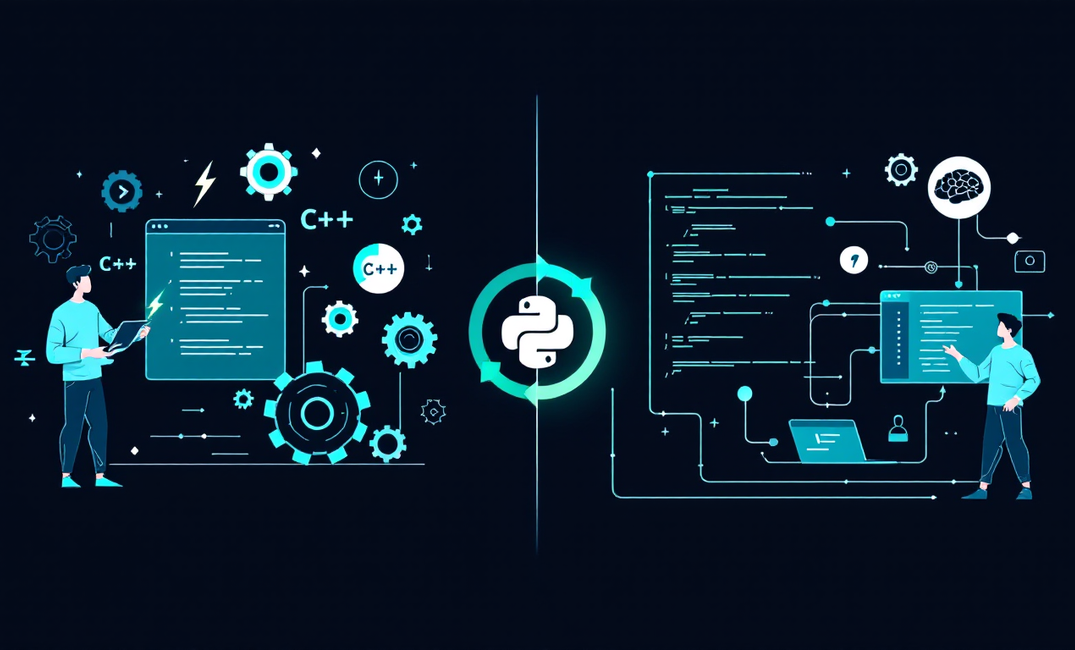Table of Contents
Programming languages come in many forms, styles, and paradigms.
But one of the most foundational distinctions in how they work under the hood is how your code is executed, and it can compiled or interpreted.
This distinction affects performance, portability, development speed, and even how errors are caught.
In this article, we’ll explore:
- What compiled and interpreted languages are
- How they differ in execution
- Examples of each
- Pros and cons
- Hybrid models
- How to choose the right tool for the job
This book offers an in-depth exploration of Python's magic methods, examining the mechanics and applications that make these features essential to Python's design.
What Does “Compiled” Mean?
A compiled language is one that is translated entirely into machine code before it’s run.
This translation is handled by a compiler, which turns your source code into an executable binary.

When you write a program in C++ and compile it with g++, it creates an executable file (like main.exe or a.out).
This file is what runs, and it doesn’t need the compiler again unless you change the source code.
Common Compiled Languages
- C / C++ – Low-level, high-performance languages often used in system software, game engines, and embedded systems. C++ adds object-oriented features to C.
- Rust – A modern systems programming language focused on safety, concurrency, and performance without a garbage collector. Great for writing safe and fast code.
- Go (Golang)– Developed at Google, it is designed for simplicity and speed, with built-in support for concurrency. Popular for microservices and backend development.
- Swift – A powerful, expressive language created by Apple for iOS, macOS, and other Apple platforms. It’s safe, fast, and easy to read.
- Fortran – One of the oldest programming languages, primarily used in scientific computing, numerical simulations, and engineering applications due to its performance with mathematical operations.
What Does “Interpreted” Mean?
An interpreted language doesn’t need to be compiled into machine code ahead of time.
Instead, it is run line-by-line or instruction-by-instruction by an interpreter.

When you run a Python script with python script.py, the Python interpreter reads the code and executes it on the fly.
Common Interpreted Languages
- Python – A beginner-friendly, high-level language known for its readability and versatility. Widely used in web development, automation, data science, AI, and more.
- JavaScript – The language of the web, used to create interactive websites and web apps. Runs in all major browsers and is increasingly used on servers with Node.js.
- Ruby – A dynamic, object-oriented language famous for its elegant syntax. Popular in web development, especially with the Ruby on Rails framework.
- PHP – A server-side scripting language designed for web development. Powers many websites, including WordPress, and is easy to embed within HTML.
- Bash – A Unix shell and scripting language used for command-line automation and system administration tasks. Found in most Linux and macOS environments.
The Hybrid Model
Not all languages fit neatly into these categories.
Some use a hybrid model that combines compilation and interpretation.
Bytecode + Virtual Machines
Languages like Java and C# are first compiled into bytecode, which is not machine code but an intermediate representation.
This bytecode is then executed by a virtual machine (e.g., JVM, CLR).
These VMs often use Just-in-Time (JIT) compilation to convert bytecode into machine code at runtime for improved performance.
Hybrid Language Examples
- Java (JVM) – Java code is compiled into bytecode, which runs on the Java Virtual Machine (JVM). This makes it cross-platform and highly portable. Often used in enterprise applications, Android development, and large-scale systems.
- C# (Common Language Runtime) – Compiled into Common Intermediate Language (CIL) and executed by the .NET Common Language Runtime (CLR). C# is widely used in Windows applications, game development (via Unity), and web apps with ASP.NET.
- Python (CPython compiles to bytecode
.pyc) – While Python is typically interpreted, the standard implementation (CPython) compiles scripts into bytecode (.pycfiles), which is then interpreted by the Python virtual machine. This hybrid approach improves performance and startup times. - JavaScript (JIT-compiled in browsers like Chrome) – JavaScript was originally a purely interpreted language, but modern engines like V8 (Chrome) and SpiderMonkey (Firefox) use Just-in-Time (JIT) compilation to convert JavaScript into optimized machine code on the fly for better performance.
Comparison Table: Compiled vs Interpreted
Understanding the differences between compiled and interpreted languages helps you choose the right tool for your specific project needs.
Here's a side-by-side comparison of their key characteristics:
| Feature | Compiled Languages | Interpreted Languages |
|---|---|---|
| Speed | Very fast (native code) | Slower (line-by-line) |
| Error Detection | At compile time | At runtime |
| Portability | Often platform-specific | Highly portable |
| Development Cycle | Slower (compile, run) | Faster (edit, run) |
| Flexibility | Low (static) | High (dynamic) |
| Deployment | Requires binary | Source code + interpreter |
| Debugging | Easier after compile | Easier during execution |
Compiled languages tend to be faster and more efficient, making them ideal for performance-critical applications.
Interpreted languages, on the other hand, offer greater flexibility and a shorter development feedback loop, which makes them well-suited for scripting, prototyping, and rapid application development.
The right choice often depends on the balance you need between execution speed, portability, and developer productivity.
Real-World Trade-Offs
While the distinction between compiled and interpreted languages is technical, the implications are very practical.
Each approach comes with strengths and weaknesses that affect development speed, performance, portability, and maintainability.
The best choice depends largely on the type of application you're building and the environment in which it runs.
Compiled Languages: Best For...
Compiled languages shine in situations where speed, efficiency, and tight resource control are essential.
These languages often require more setup time but offer unmatched performance and optimization.
- High-performance applications – Such as AAA video games, 3D rendering engines, and performance-intensive simulations where execution speed is critical.
- Real-time systems – Applications that must respond to events within strict time constraints (e.g. robotics, flight control, medical monitoring systems).
- Memory-critical environments – Embedded systems like firmware in appliances, sensors, and microcontrollers where memory and CPU usage must be tightly controlled.
- Operating systems and drivers – Where low-level hardware interaction and high stability are mandatory.
Interpreted Languages: Best For...
Interpreted languages are favoured in environments where development speed, flexibility, and ease of iteration outweigh raw performance.
- Web development – Languages like JavaScript and PHP dominate client-side and server-side development for dynamic, interactive websites.
- Scripting and automation – Tasks like system administration, file manipulation, and workflow automation benefit from Python, Bash, and similar tools.
- Rapid prototyping and experimentation – Quickly testing ideas, building proof-of-concepts, or iterating on MVPs (Minimum Viable Products) with fewer compile steps.
- Data science and machine learning – Python's rich ecosystem of libraries (e.g. NumPy, pandas, TensorFlow) and interactive environments (like Jupyter) make it ideal for exploratory work and model development.
Hybrid Languages: Best For...
Many modern languages and runtimes combine compilation and interpretation to deliver both performance and flexibility.
These hybrid approaches offer the structure and speed of compiled code along with the dynamism and portability of interpreted systems.
- Cross-platform applications – Languages like Java and C# compile to bytecode that runs on virtual machines (JVM and CLR), making deployment across operating systems seamless.
- Enterprise software – Platforms like .NET and the Java ecosystem are widely used in enterprise environments for large, maintainable, and secure business applications.
- Mobile development – Hybrid runtimes allow code to be compiled once and run anywhere. For instance, Android apps (Java/Kotlin) run on the Android Runtime (ART), while Xamarin (C#) targets iOS and Android.
- High-performance scripting – Languages like JavaScript, through Just-In-Time (JIT) compilation in engines like V8 (Chrome) or SpiderMonkey (Firefox), enable dynamic scripting with near-native execution speed.
- Scientific computing with some Python setups – Tools like PyPy (a JIT-compiled Python implementation) or Numba (which compiles Python functions to machine code) boost performance for data-intensive applications without giving up Python’s ease of use.
Choosing the Right Tool
Choosing between a compiled or interpreted language isn't just about technical preferences, it's about matching the tool to the needs of your project.
When making your decision, consider the following questions:
- Does performance matter more than development speed?: If you're building something that must run as fast as possible (e.g. a game engine or a trading algorithm), compiled languages are often the better choice.
- Will the software be deployed to many platforms?: Interpreted or hybrid languages with portable runtimes (like Java’s JVM or Python) may simplify cross-platform deployment.
- Is runtime flexibility important (e.g. using
eval()or dynamic typing)?: Interpreted languages often allow more dynamic behaviour at runtime, which can be powerful, but also harder to optimize or secure. - Will the project benefit from early error checking?: Compiled languages typically catch more errors at compile time, which can help reduce bugs in large, complex codebases.
Rule of Thumb
Use compiled languages when you need raw speed, tight control, or long-term stability.
Use interpreted languages when you need rapid iteration, cross-platform convenience, or flexible scripting.
In reality, many modern applications use both.
For example, a compiled backend written in Go or Rust might expose APIs consumed by a frontend built with JavaScript, or use Python for scripting internal tools.
The key is to choose the right tool for the job, not the most popular one.
Conclusion
Understanding the difference between compiled and interpreted languages empowers you to write better, more efficient code and make smarter decisions about which language or platform best fits your project’s needs.
Although the line between these categories used to be clear-cut, modern programming trends increasingly favor hybrid models that combine the performance of compiled languages with the flexibility of interpreted ones.
Ultimately, there is no single "best" language, only the right tool for the task at hand.
My name is Nuno Bispo (a.k.a. Developer Service), and I love to teach and share my knowledge.
This blog is mostly focused on Python, Django and AI, but Javascript related content also appears from time to time.
Feel free to leave your comment and suggest new content ideas. I am always looking for new things to learn and share.
Follow me on Twitter: https://twitter.com/DevAsService
Follow me on Instagram: https://www.instagram.com/devasservice/
Follow me on TikTok: https://www.tiktok.com/@devasservice
Follow me on YouTube: https://www.youtube.com/@DevAsService


